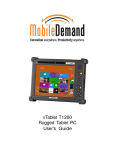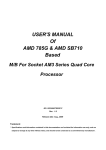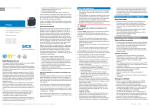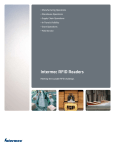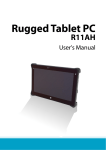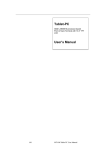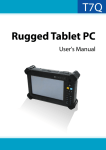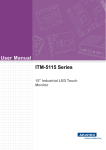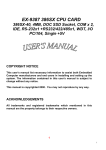Download Rugged Computing TA10iT Specifications
Transcript
TA10iT Table of Contents COPYRIGHT ................................................................................................. 4 REGULATORY STATEMENT ................................................................................. 4 Federal Communications Commission Statement .......................................................................................................... 4 Declaration of Conformity ............................................................................................................................................... 4 RF exposure warning........................................................................................................................................................ 5 Canada, Industry Canada (IC) Notices ........................................................................................................................... 5 Battery Disposal................................................................................................................................................................ 6 CLASS 1 LASER PRODUCT ........................................................................................................................................... 6 BEFORE YOU START ................................................................ 8 PACKAGE CONTENTS ...................................................................................... 8 FEATURES ................................................................................................... 9 COMPONENTS ............................................................................................ 10 Front View ....................................................................................................................................................................... 10 Back View ........................................................................................................................................................................ 12 Left View .......................................................................................................................................................................... 13 Right View........................................................................................................................................................................ 13 Bottom View..................................................................................................................................................................... 14 Status Indicators.............................................................................................................................................................. 15 GETTING STARTED ................................................................ 16 POWERING UP YOUR TABLET PC ...................................................................... 16 Connecting the AC Adapter............................................................................................................................................ 16 Using Battery Power ...................................................................................................................................................... 16 INSTALLING THE BATTERIES ............................................................................ 17 Charging the Battery ...................................................................................................................................................... 17 Charging Time ................................................................................................................................................................ 18 Checking the Battery Level............................................................................................................................................. 18 Checking the Battery Pack Power Level ....................................................................................................................... 19 When to replace the Battery Pack .................................................................................................................................. 19 Removing the Batteries ................................................................................................................................................... 19 STARTING YOUR TABLET PC............................................................................ 21 Turning On Your Tablet PC ........................................................................................................................................... 21 Changing the Display Orientation ................................................................................................................................. 21 Shutting Down Your Tablet PC...................................................................................................................................... 21 USING THE STYLUS ...................................................................................... 22 Calibrate the Screen ....................................................................................................................................................... 22 USING THE QUICK MENU ............................................................................... 23 CONFIGURING THE SETUP MENU SETTINGS ........................................................ 25 Configuring Hotkey ........................................................................................................................................................ 26 Configuring Stealth Mode Button Setting ...................................................................................................................... 27 Configuring External WWAN Antenna Switching Mode .............................................................................................. 28 2 Configuring Light Sensor Settings ................................................................................................................................. 29 Configuring Keypad Backlight Timeout Setting ............................................................................................................ 30 USING THE CAMERA ..................................................................................... 31 USING THE MEMORY CARDS ........................................................................... 35 Inserting a Memory Card ............................................................................................................................................... 35 Removing a Memory Card ............................................................................................................................................. 35 USING THE SMART CARD ............................................................................... 36 Inserting a Smart Card ................................................................................................................................................... 36 USING THE SIM CARD .................................................................................. 37 Inserting a SIM Card ...................................................................................................................................................... 37 USING THE PC CARDS .................................................................................. 38 Inserting a PC Card........................................................................................................................................................ 38 CONNECTING TO WIRELESS CONNECTIONS ......................... 39 CONNECTING TO A WIRELESS LOCAL AREA NETWORK ............................................. 39 CONNECTING TO A BLUETOOTH DEVICE .............................................................. 40 CONNECTING TO A WIRELESS WIDE AREA NETWORK (WWAN) ................................. 41 USING THE BIOS SETUP UTILITY .......................................... 43 BIOS SETUP MENU ..................................................................................... 43 STARTING THE BIOS SETUP UTILITY ................................................................. 43 NAVIGATING AND ENTERING INFORMATION IN BIOS............................................... 44 MAIN MENU .............................................................................................. 45 ADVANCED MENU ........................................................................................ 45 BOOT MENU .............................................................................................. 46 SECURITY MENU ......................................................................................... 46 SAVE & EXIT MENU ..................................................................................... 47 SPECIFICATIONS .................................................................. 48 Preface Copyright Copyright© 2013. All rights reserved. No part of this user manual may be transmitted, stored in a retrieval system, or translated into any language or computer language, in any form or by any means, without the prior written permission of the manufacturer. Information is subject to change without prior notice. Regulatory Statement Federal Communications Commission Statement This equipment has been tested and found to comply with the limits for a Class B digital device, pursuant to Part 15 of the FCC Rules. These limits are designed to provide reasonable protection against harmful interference in a residential installation. This equipment generates, uses, and can radiate radio frequency energy and, if not installed and used in accordance with the instructions, may cause harmful interference to radio communications. However, there is no guarantee that interference will not occur in a particular installation. If this equipment does cause harmful interference to radio or television reception, which can be determined by turning the equipment off and on, the user is encouraged to try to correct the interference by one or more of the following measures: Reorient or relocate the receiving antenna. Increase the separation between the equipment and the receiver. Connect the equipment into an outlet on a circuit different from that to which the receiver is connected. Consult the dealer or an experienced radio/TV technician for help. Shielded interconnect cables and shielded AC power cable must be employed with this equipment to insure compliance with the pertinent RF emission limits governing this device. Changes or modifications not expressly approved by the system's manufacturer could void the user's authority to operate the equipment. Declaration of Conformity This device complies with part 15 of the FCC rules. Operation is subject to the following conditions: This device may not cause harmful interference This device must accept any interference received, including interference that may cause undesired operation. 4 Preface RF exposure warning This equipment must be installed and operated in accordance with provided instructions and must not be co-located or operating in conjunction with any other antenna or transmitter. End-users and installers must be provided with antenna installation instructions and transmitter operating conditions for satisfying RF exposure compliance. SAR Value: 0.317W/kg This device is operation in 5.15 – 5.25GHz frequency range, then restricted in indoor use only, Outdoor operations in the 5150~5250MHz is prohibit. This device is slave equipment, the device is not radar detection and not ad-hoc operation in the DFS band. Canada, Industry Canada (IC) Notices This Class B digital apparatus complies with Canadian ICES-003 and RSS-210. Operation is subject to the following two conditions: (1) this device may not cause interference, and (2) this device must accept any interference, including interference that may cause undesired operation of the device. Radio Frequency (RF) Exposure Information The radiated output power of the Wireless Device is below the Industry Canada (IC) radio frequency exposure limits. The Wireless Device should be used in such a manner such that the potential for human contact during normal operation is minimized. This device has been evaluated for and shown compliant with the IC Specific Absorption Rate (“SAR”) limits when installed in specific host products operated in portable exposure conditions. Canada, avis d'Industry Canada (IC) Cet appareil numérique de classe B est conforme aux normes canadiennes ICES003 et RSS-210. Son fonctionnement est soumis aux deux conditions suivantes : (1) cet appareil ne doit pas causer d'interférence et (2) cet appareil doit accepter toute interférence, notamment les interférences qui peuvent affecter son fonctionnement. Informations concernant l'exposition aux fréquences radio (RF) La puissance de sortie émise par l’appareil de sans fil est inférieure à la limite d'exposition aux fréquences radio d'Industry Canada (IC). Utilisez l’appareil de sans fil de façon à minimiser les contacts humains lors du fonctionnement normal. 5 Preface Ce périphérique a été évalué et démontré conforme aux limites SAR (Specific Absorption Rate – Taux d'absorption spécifique) d'IC lorsqu'il est installé dans des produits hôtes particuliers qui fonctionnent dans des conditions d'exposition à des appareils portables. Battery Disposal THIS PRODUCT CONTAINS A LITHIUM-ION OR NICKEL-METAL HYDRIDE BATTERY. IT MUST BE DISPOSED OF PROPERLY. CONTACT LOCAL ENVIRONMENTAL AGENCIES FOR INFORMATION ON RECYCLING AND DISPOSAL PLANS IN YOUR AREA. CLASS 1 LASER PRODUCT LASERSCHUTZKLASSE 1 PRODUKT TO EN60825 CAUTION: THIS APPLIANCE CONTAINS A LASER SYSTEM AND IS CLASSIFIED AS A "CLASS 1 LASER PRODUCT.” TO USE THIS MODEL PROPERLY, READ THE INSTRUCTION MANUAL CAREFULLY AND KEEP THIS MANUAL FOR FUTURE REFERENCE. IN CASE OF ANY TROUBLE WITH THIS MODEL, PLEASE CONTACT YOUR NEAREST "AUTHORIZED SERVICE STATION.” TO PREVENT DIRECT EXPOSURE TO THE LASER BEAM, DO NOT TRY TO OPEN THIS ENCLOSURE. ANNEX IV Symbol for the marking of electrical and electronic equipment The symbol indicating separate collection for electrical and electronic equipment consists of the crossed-out wheeled bin, as shown below. The symbol must be printed visibly, legibly and indelibly. 6 Preface CAUTION FOR ADAPTER THIS TABLET PC IS FOR USE WITH DEDICATED AC ADAPTER. BATTERY SAFETY DANGER OF EXPLOSION IF BATTERY IS INCORRECTLY REPLACED. REPLACE ONLY WITH THE SAME OR EQUIVALENT TYPE RECOMMENDED BY THE MANUFACTURER. DISPOSE OF USED BATTERIES ACCORDING TO THE MANUFACTURER'S INSTRUCTIONS. CAUTION FOR RJ-45 The RJ-45 jack is not used for telephone line connection. 7 Before You Start Before You Start Congratulations on your purchase of this tablet PC. This rugged tablet PC is portable and provides users with maximum mobile computing experience in a wide range of working environments. Before you begin using your tablet PC, read this chapter to familiarize yourself with the main components installed in the system. Package Contents If any of following items is damaged, please contact your retailer. • 8 Tablet PC Power adapter Stylus Pen Hand-strap Power cord NOTE The pictures are for reference only, actual items may slightly differ. Before You Start Features • Intel Ivy Bridge CPU • Rugged feature: 5 feet drop and dust/waterproof IP 65 • Multi-touch • Two battery packs support 10~12 hrs battery life and hot swapping • Support LTE • Optional barcode scanner (support 1D/2D barcode reading) • Optional Finger print scanner(FIPS 201) • Optional UHF RFID reader support ISO 18000-6C 9 Before You Start Components Front View No. Item Description 1 Status Indicators (Power, Battery, HDD, Wireless) Indicate the corresponding function status. See “Status Indicators” on page 15. 2 Camera Use to take pictures. 3 Speaker Emit sound. 4 Fingerprint Scanner Scan your fingerprint to prevent access to your tablet PC by unauthorized users. 5 Scanner button Press to trigger the Barcode scan function if the barcode scanner is on. It can also be assigned to launch a specific Windows-based program via Quick Menu. 6 Camera button Press to activate the Camera function. 7 Power button Press to power on and off the tablet PC. 8 Stealth mode button Press to disable all emitting lights and sound. And, press again for resuming the above devices to the last states. 10 Before You Start No. Item Description Security button Press to exit Windows and enter SAS (Secure Attention Sequence) mode. 10 Quick menu Press to access the Quick menu. 11 Tab button Press to emulate the Tab key. 12 Backspace button Press to emulate the Backspace key. 13 Function button When Function Button is locked, use the other keys to perform special functions. • < > + < >: Increase screen brightness. 9 • • • • • • < > + < >: Decrease screen brightness. < > + < >: Increase audio volume. < > + < >: Decrease audio volume. < >+< >: Emulate the Escape key. > + <TAB>: Access your favorite < program (Program1). < >+< >: Access your favorite program (Program2). 14 Enter button Press to emulate the Enter key. 15 Up button Press to emulate the Up key. 16 Left button Press to emulate the Left key. 17 Right button Press to emulate the Right key. 18 Down button Press to emulate the Down key. 19 Home button Press to return to Home screen (for Windows 8 only). 11 Before You Start Back View No. Item Description 1 Camera LED flash Provide additional lighting when taking pictures under low light environment. 2 Camera Use to take pictures. 3 Battery latch Lock the battery in place. 4 Battery compartment Contain the battery. 5 Battery LED indicator Press the button to display the remaining battery power level. 6 Battery latch release button Press and hold the button to slide the battery latch to the unlock position. 7 HDD compartment Contain the hard disk drive. If you are using mSATA SSD, you can insert the second battery to this compartment. 12 Before You Start Left View No. Item Description 1 Kensington lock slot Connect to a Kensington-compatible tablet PC security lock. 2 Mini USB port Connect USB peripheral devices. 3 Serial port (RS-232) Connect a peripheral device, such as a printer or other device with serial port. 4 LAN (RJ-45) port Connect to a local area network (LAN) using an Ethernet cable. 5 DC-in jack Connect the power adapter. Right View No. Item Description 1 Earphone jack Connect headphones. 2 USB ports Connect USB peripheral devices. 3 PC Card slot Use to insert Type II PC Card 4 SIM card slot Use to insert a SIM card for WWAN, Gobi 3000, or 13 Before You Start No. Item Description LTE module connection. 5 Card reader Use to insert memory cards to transfer pictures, music, and data between your tablet PC and flash compatible devices. The card reader supports SD (Secure Digital), SDHC, Mini-SD (with adapter). 6 Smart card reader Use to insert smart cards. Bottom View No. Item Description 1 External GPS Antenna connector Connect the tablet PC to an external GPS antenna when using a docking station. 2 External WWAN Antenna connector Connect the tablet PC to an external WWAN antenna when using a docking station. 3 Docking station port Connect the tablet PC to a docking station. 14 Before You Start Status Indicators The status indicators in the upper left corner of the tablet PC light up when a particular function of the tablet PC is active. Each indicator is marked with a symbol. Icon Item Description Power The LED always lights on (blue) when the system is running. When the system is in sleep mode, the LED blinks. Battery Indicate the battery status: • Green light means the battery is fully charged or the charging current is 0 for more than 3 minutes with the battery capacity higher than 95%. • Blinking green light means the system is calibrating the battery. • Orange light means the battery is being charged. • Blinking orange light means the battery is being charged but the battery temperature is out of charging range (0~60ºC), the battery is being charged for more than 10 hours, or the charging current is 0 for more than 3 minutes with the battery capacity lower than 85%. • Blinking red light means the battery power is low (less than 7%). HDD Indicate the HDD or HDD heater status: • Green light indicates the HDD activity (data is being read or written). • Blinking orange light means the heater of 2.5” HDD is heating. RF Indicate the status of RF (WLAN, WWAN, Bluetooth, or GPS) communication. The LED always lights on (blue) when the function is enabled. 15 Getting Started Getting Started This chapter will guide you on how to use your tablet PC. Powering Up Your Tablet PC Your tablet PC can be powered up using the AC adapter or the Lithium-ion battery. Connecting the AC Adapter The AC adapter powers up your tablet PC and charges the battery. 1. Connect the AC adapter to the DC-in jack of your tablet PC. 2. Connect the AC adapter to the power cord. 3. Plug the power cord to an electrical outlet. Using Battery Power 1. Install a charged battery in the battery compartment. 2. Remove the AC adapter (if plugged). Your tablet PC will automatically use the battery power. NOTE 16 Getting Started • If your tablet PC is connected to an electrical outlet and the battery is installed, your tablet PC uses power from the electrical outlet. Installing the Batteries To install the batteries, follow the steps below: 1. Align and insert the first battery to the battery compartment. 2. Push completely until the battery locks into place. 3. Slide the battery latch to the lock position to secure the battery. 4. Repeat Step 1 to 3 to insert the second battery. Charging the Battery The Lithium-ion battery is not fully-charged upon purchase. To charge the battery, follow the steps below: 1. Install the battery to your tablet PC. See procedures above. 2. Connect the AC adapter to the DC-in jack of your tablet PC. 3. Connect the AC adapter to the power cord. 4. Plug the power cord to an electrical outlet. 17 Getting Started Charging Time Number of battery pack Charging duration (at 25ºC) 1 2 3 hours 6 hours • NOTE The charging time may be longer if you are using your tablet PC while charging the battery. CAUTION • DO NOT charge the battery if the temperature is below 0ºC or higher than 60ºC. • Use only the supplied AC adapter. Using other AC adapters may damage the battery or your tablet PC. Checking the Battery Level It is important that you monitor the battery status regularly to ensure you do not run out of power at a critical moment. To check the remaining battery power, double tap the battery icon in the system tray. The battery screen appears: 18 Getting Started Checking the Battery Pack Power Level You can check the battery level by pressing the Battery Check button. The remaining battery power is indicated by the four Green LEDs. Green LED status 1st LED lights up 1st and 2nd LED light up 1st, 2nd, and 3rd LED light up All four LEDs light up Battery Capacity Status 0% ≦ 25% 25% ≦50% 50% ≦75% 75% ≦100% When to replace the Battery Pack The battery performance gradually decreases over time and usage. We recommend you to replace your battery pack after 18 to 24 months of usage. Removing the Batteries To remove the batteries, follow the steps below: 1. Press and hold the battery latch release button to slide the second battery latch to the unlock position. 2. Remove the second battery out of the battery compartment. 19 Getting Started 3. Repeat Step 1 and 2 to remove another battery. 20 Getting Started Starting Your Tablet PC Turning On Your Tablet PC Press the button until the Power LED lights up. Changing the Display Orientation You can rotate the display orientation to suit your preference. Press both < > and <7> buttons to rotate the display 90° clockwise. NOTE • • You need to disable the Auto Rotate option in the Quick menu before pressing the shortcut buttons (< > + <7>) to rotate the display. The screen can’t be turned 180 and 270 degree clockwise to operate. Shutting Down Your Tablet PC It is important to properly shut down your tablet PC to avoid the loss of unsaved data. To shut down your tablet PC, do the following: Tap Start > Shut down. Wait for your tablet PC to turn off power completely before removing the power source (if necessary). 21 Getting Started Using the Stylus This tablet PC comes with an integrated stylus for accurate control input to the LCD touch panel and digitizer. You can use the stylus to point, select, or drag items or objects on the screen. Calibrate the Screen To ensure touch accuracy, calibrate the screen. 1. Tap Start > Control Panel. 2. Select Hardware and Sound > Tablet PC Settings. 3. Tap Calibrate. 4. Follow the on-screen instructions to complete screen calibration. NOTE If the optional digitizer is enabled, use a pencil to do the touch panel • calibration instead of using the digitizer pen. 22 Getting Started Using the Quick Menu There are two ways to enter the Quick menu: • Tap • Tap the arrow on the system tray to display hidden icons. Then tap the Quick Menu icon ( ). . 1 2 3 4 13 12 11 5 6 10 7 8 9 No. Item Description 1 WLAN Tap the icon to enable/disable the Wi-Fi (WLAN) function. 2 WWAN Tap the icon to enable/disable the WWAN function. 3 Bluetooth Tap the icon to enable/disable the Bluetooth function. 4 GPS Tap the icon to enable/disable the GPS function. 5 Auto-rotate Tap the icon to enable/disable the Auto-Rotate screen function. 6 Keypad Backlight Tap the icon to turn the keypad backlight on/off. 23 Getting Started No. Item Description 7 Setup 8 Information Tap the icon to view the battery charge cycle, Bios version, EC version, and Quick Menu version. 9 Keyboard Tap the icon to display/hide the on-screen keyboard. 10 Mobility center Tap the icon to adjust brightness, screen orientation, volume, external display, battery status, sync, wireless network, and presentation settings. 11 Barcode Tap the icon to trigger the Barcode Scanner function. 12 RFID Tap the icon to trigger the RFID function. 24 Tap the respective tab to set hotkey, light sensor, keypad backlight, stealth mode button, and external WWAN antenna settings. For details, refer to “Configuring the SETUP Menu Settings”. Getting Started No. 13 Item Airplane mode Description Tap the icon to enable/disable airplane mode. • NOTE When the Airplane mode is enabled, the wireless network (WLAN and WWAN), Bluetooth, and GPS will be automatically disabled. NOTE • If the icon is gray (i.e. ), this indicates the current function is disabled. Configuring the SETUP Menu Settings In Quick Menu, you can set the following settings via Setup menu: b c a d e a. b. c. d. e. Hotkey Stealth mode button External WWAN antenna Keypad backlight Light sensor 25 Getting Started Configuring Hotkey Tap the Hotkey tab to configure the scanner button or the P1 and P2 function buttons. • If the device is not installed with a barcode scanner, the Scanner button (see page 10) can be set as a programmable button. • To assign an application to the P1 or P2 button, do the following: I. Tap the folder icon ( ) to set up an application for the P1 or P2 button. II. Select the desired application and tap Open. 26 Getting Started Configuring Stealth Mode Button Setting Tap the Stealth Mode Button tab to specify the Stealth mode button (see page 10) function. There are three available functions: • Stealth mode: Turn off the LCD backlight, LEDs (LED indicators and keypad backlight), speakers, camera flash, and RF devices except GPS. • Night vision mode: Adjust the brightness of the LCD under 1.7 nits and turn off the LEDs (LED indicators and keypad backlight) and camera flash. • Off: Disable the stealth mode function. 27 Getting Started Configuring External WWAN Antenna Switching Mode Tap the External WWAN Antenna tab to enable/disable the device to automatically switch to the external WWAN antenna when it is affixed on a docking station. • Dock with external WWAN antenna: The device automatically switches to the external WWAN antenna when docking. • Dock without external WWAN antenna: The device will disable the auto switch function to the external WWAN antenna when docking. 28 Getting Started Configuring Light Sensor Settings Tap the Light Sensor tab to enable/disable the automatic light sensor function, specify and adjust the brightness level. Current ambient brightness reading Current preset brightness level Tap to restore the default settings. Set the range of illumination settings. To setup the light sensor settings, do the following: • To customize the illumination range according to the ambient lighting, enter the desired value in the first and second data box. As an example in the above illustration: - Outdoor (5000 ~ 500 lux) - Indoor (500 ~ 50 lux) - Low Light (50 ~ 0 lux). • To adjust the brightness level according to the ambient light, tap or to adjust the setting (0~10). • To save all preset settings, tap Apply. • To enable the automatic light sensor function, tap the Enable Auto Light Sensor checkbox. The system will automatically adjust the LCD brightness according to the preset settings. 29 Getting Started Configuring Keypad Backlight Timeout Setting Tap the Keypad Backlight tab to adjust delay before the Keypad Backlight automatically goes off. Tap the desired length of time. Your setting is automatically saved. 30 Getting Started Using the Camera This tablet PC supports Durabook Camera Scan application that enables users to take photos using the device camera. Launch the application There are two ways to launch the application: • Double-click “DuraBook Camera Scan” • Tap Start > All Programs > DuraBook. on desktop. unknown Take Photos Press the Record button to capture the pictures. View Photos • Press the Forward or Backward button “ / ” to view the recorded photos. • Press the Play button “ • In Playback mode, press the Preview button “ ” to switch to Playback mode. ” to switch back to Camera mode. 31 Getting Started Delete Photos 1. Press the Play button “ ” to switch to Playback Mode. 2. Use the Forward or Backward button “ / ” to select the photo that you want to delete. 3. Press the Delete button “ ” and then choose Yes to delete the current photo. Record GPS Coordinates (Geotagging) is the GPS signal status located on the top right corner of the main program. GPS device must be implemented in the system for locating the positions and recording the coordinates when capturing photos. If GPS coordinates are not able to be received, the last coordinates would be used instead. GPS status indicator GPS device is working properly GPS device is not available GPS signals are unstable If the user decided to use the external USB GPS device, do the following: 1. Press the Setup button “ 2. Tap ” to enter the Setup menu. > Auto Scan Comport. The detected Port Number is displayed on the screen. 32 Getting Started How to Make Adjustments on Features: Press the Setup button “ ” to enter the Setup menu. Camera Selection: There are three cameras that you can select: • “ ” – the camera is available and ready to use. • “ ” - the camera is not available. Press the Leave button “ . ” after you have chosen the desired camera. Resolution: There are four resolution options that you can select: . If the Camera does not support these four resolutions, a “Change Resolution Error” message will appear on the screen. Press the Leave button “ ” to exit. (Native: maximum resolution) 33 Getting Started Preview Size: There are two preview size options that you can select: Press the Leave button “ . ” after you have chosen the desired preview size. Geotagging: Tap ON to enable the Geotagging feature. Press the Leave button “ • • ” to exit. NOTE The Geotagging feature will only be activated if the tablet PC is equipped with the GPS module. The camera logs the GPS position accurately if photos are taken outdoor. Flash: When capturing photos under the low light environment, tap ON to turn on the LED Flash. • NOTE The effective flash range is 50cm. Idle Timing: There are five Idle Timing options that you can select: . Press the Leave button “ • 34 ”after you have chosen the desired time. NOTE When the system is left idle for a certain period of time, the camera module(s) would then stop running. It would be up and running again once user wakes up the “DuraBook” application. Getting Started Using the Memory Cards Your tablet PC supports different types of memory cards to provide faster data transfer. Supported types are as follows: • SD card • SDHC card • Mini-SD card (with adapter) Inserting a Memory Card 1. Push down and pull to open the I/O port cover. 2. With the label side down, push the memory card into the memory card slot until it clicks into place. Removing a Memory Card It is important to remove the memory card properly. Improper removal may cause the data in the memory card to be corrupted and your tablet PC to malfunction. To properly remove the memory card, follow the steps below: 1. Tap the removable disk icon on the system tray. 2. Tap Eject SD Card. The system confirms that the device can be safely removed. 3. Push the memory card to eject it. 4. Pull the card out from the slot. 35 Getting Started Using the Smart Card Your tablet PC is equipped with a built-in smart card reader that allows you to make secure purchases, store security information, and provide identification and information using a smart card. Inserting a Smart Card 1. Push down and pull to open the I/O port cover. 2. Insert a smart card into the smart card slot. 36 Getting Started Using the SIM Card You can use a SIM card for wireless internet access. • NOTE Check the availability of service and plan rates of data connection with your network service provider. Inserting a SIM Card 1. Push down and pull to open the I/O port cover. 2. Insert a valid SIM card into the SIM card slot until it clicks into place. 37 Getting Started Using the PC Cards Your tablet PC supports Type II PC Card, which can perform a variety of functions. • NOTE Refer to the PC Card manual for specific instructions on the card installation. Inserting a PC Card 1. Push down and pull to open the I/O port cover. 2. Insert a PC card firmly into the PC card slot until it clicks into the connector. 38 Connecting to Wireless Connections Connecting to Wireless Connections You can connect your tablet PC to a wireless local area network, WWAN, Bluetooth, or GPS. Before using a wireless built-in device, you need to turn the respective built-in wireless functions on. Connecting to a Wireless Local Area Network Your tablet PC comes with a WLAN module. A wireless network can be added either when the network is detected or by manually entering the settings information. To connect, follow the steps below: 1. Press the button to open the Quick menu. 2. Tap the WLAN icon ( ) to turn on the wireless network function. 3. Tap the wireless network icon ( ) on the system tray. 4. Available wireless network connections are displayed. Tap the desired wireless network. 5. Tap Connect. Some networks require a network security key or a password. TIP Check Connect automatically box to automatically connect to this network when it is available. 6. Enter the network security key. 7. Tap OK. 39 Connecting to Wireless Connections 8. After the connection is established, you can see the wireless icon ( Notification area. • • ) in the NOTE Wi-Fi access requires service from a wireless service provider. Contact your service provider for more information. Actual wireless connectivity will depend on system configuration. Please contact your dealer for more information. Connecting to a Bluetooth Device Your tablet PC can connect and communicate with other Bluetooth-enabled devices. To add a device, follow the steps below: 1. Press the button to open the Quick menu. 2. Tap the Bluetooth icon ( ) to turn on the Bluetooth function. 3. Tap the arrow on the system tray to display hidden icons. 4. Tap the Bluetooth icon ( ). 5. Tap Add a Device. The system starts scanning for Bluetooth devices and displays the available devices. NOTE • If the device that you want to add does not appear on the screen, please check if the device is turned on and discoverable. 6. Tap on a device, then tap Next to continue. 40 Connecting to Wireless Connections 7. Tap Close to complete the pairing connection. • • NOTE Most Bluetooth-enabled devices need to be paired with your tablet PC. The PIN you enter on the tablet PC must be the same PIN to be entered on the other Bluetooth device. Once a partnership has been created, connecting to that device again will no longer require entering the PIN. Connecting to a Wireless Wide Area Network (WWAN) 41 Connecting to Wireless Connections With WWAN function, it allows your tablet PC to connect to the Internet using mobile or cellular data networks. To enable the function, follow the steps below: 1. Insert a valid SIM card into the SIM card slot. See “Inserting a SIM Card” on page 37. 2. Press the button to open the Quick menu. 3. Tap the WWAN icon ( WWAN function. ) to turn on the 4. Launch AirCard Watcher application. • On Windows desktop, tap “AirCard Watcher” ( ). • Tap Start > AirCard Watcher. 5. Tap Connect to enable the Internet connection via mobile data network. 6. To disconnect the connection, tap Disconnect. 42 Using the BIOS Setup Utility Using the BIOS Setup Utility Your tablet PC has a BIOS setup utility which allows you to configure important system settings, including settings for various optional functions of the tablet PC. This chapter explains how to use the BIOS setup utility. BIOS Setup Menu The BIOS Setup Utility allows you to configure your tablet PC basic settings. When you turn your tablet PC on, the system reads this information to initialize the hardware so that it can operate correctly. Use the BIOS setup utility to change your tablet PC start-up configuration. For example, you can change the security and power management routines of your system. Starting the BIOS Setup Utility You can only enter the BIOS setup utility as the tablet PC is booting, that is between the time you turn on the tablet PC and before the Windows interface appears. If your tablet PC is already on, shut down your tablet PC completely (power off) and restart it and then press the button to enter the setup utility. 43 Using the BIOS Setup Utility Navigating and Entering Information in BIOS Use the following keys to move between fields and to enter information: Tablet Keypad / External Keyboard / < Description Selects screen. Moves up/down to select items. Enter Confirms the selection and enters the selected menu screen. / +/- Changes an option for the selected items. - F1 F2 F3 F4 > + <9> Esc Displays the Help screen. Invokes the previous values. Loads optimized default values. Saves the changes and exits Setup. Exits any section. If you wish to exit the BIOS utility without saving changes or go to the main menu, then press this key. Users are allowed to enter new values to replace the default settings in certain fields, and the rest of the fields are specified by system default parameters and cannot be modified by users. Reverse the attribute of the main options and press the button to enter into the submenu. Press both < buttons to return to the previous configuration page. 44 > + <9> Using the BIOS Setup Utility Main Menu The Main menu displays the system overview information about BIOS version, CPU features, and total memory size. You can also set the system date and time. Advanced Menu The Advanced menu allows you to select SATA mode, set the keypad backlight timer, BIOS hotkey press, calibrate fan and battery, and configure devices, power management, Intel Rapid Start Technology, and Trusted Computing settings. 45 Using the BIOS Setup Utility Boot Menu The Boot menu allows you to configure the boot type and boot sequence. Security Menu The Security menu allows you to set or change the Administrator and User passwords, and configure Secure Boot settings. 46 Using the BIOS Setup Utility Save & Exit Menu The Save & Exit menu allows you to save or discard the changes, or restore the default values for all setup options before leaving the BIOS Setup Menu. 47 Specifications Specifications Features Processor Specifications Type & Speed i3-3217UE 1.6 GHz with 3MB L3 Cache i7-3517UE 1.7 GHz with 4MB L3 Cache i5-3427U 1.8 GHz with 3MB L3 Cache QM77 Chipset System Memory Type Maximum Memory Two 204-pin SODIMM sockets each for DDRIII1600 2GB, 4GB, 8GB Screen Auto-rotation 16GB Standard: : 10.4” XGA (1024x768) LCD with resistive multi-touch panel Sunlight readable: 10.4” XGA (1024x768) High brightness LCD with sunlight readable resistive multitouch panel Support screen auto-rotation Light Sensor Built-in ambient light sensor Digitizer Optional 10.4” Digitizer with active stylus Display Display Auto switch between digitizer and touch input Storage SSD Expansion Slot Camera I/O Devices Barcode scanner RFID Finger Print Scanner Communications 48 mSATA SSD 64/128 GB Optional 2.5” 9.5mm SATA HDD 320/500/750GB PCMCIA Optional Smart card reader SD card slot (SDHC) Front facing 1.3M pixel camera Optional rear facing 5M pixel auto-focus camera Optional Barcode scanner, support 1D, 1D/2D barcode Optional UHF RFID reader support ISO 180006C Optional Finger print scanner which pass FIPS 201 Internal 10/100/1000M bit Ethernet LAN Intel WiFi 6235 module that supports 802.11a/b/g/n and Bluetooth Specifications Features Specifications I/O Ports Audio AC/DC Adapter Power Battery Life Second Battery Environment Operating Temperature Storage Temperature Operating Humidity Drop Dust Proof/Water Sealing Vibration Optional WWAN (Gobi 3000 or LTE module ) Optional GPS Left Side I/O: RS-232x1(Support 5 Voltage), RJ 45x1,mini USBx1, DC-inx1 Right Side I/O: USB 3.0x2, Audio out (For headphone)x1 Optional RF connectors for external WWAN and GPS antennas HD Audio One speaker Analog Mic. Array (With 2 Microphones) AC power input:100V-240V,50Hz-60Hz, 65W ;output:19V Compliant with Energy Star 5.2 One 6 cells battery pack (5200mAh, 57.72 W) is 5~6 hrs. Support optional second Battery 2nd battery is available if main-storage is mSATA SSD -20℃~ 60℃ -51~71℃ 5% ~ 95% 26 drops with 5 feet high to 2” plywood over concrete, unit on with SSD IP65 Mil Std 810G 514.6 Procedure I category 24 Figure 514.6E-1 (Transportation) General Minimal Integrity, unit on with SSD Salt fog Mil Std 810G 509.5 Operating System Windows 7 32 bit , 64 bit version Window 8 Security TPM 1.2 Kensington Lock slot Intel AT or Computrace Dimensions 285.6(W)X221.5(H)X41.5(D)mm/11.2(W)x8.7( H)x1.6 inch Weight Weight: 2.3 Kg/5 Pound Specifications are subject to change without prior notice. 49

















































